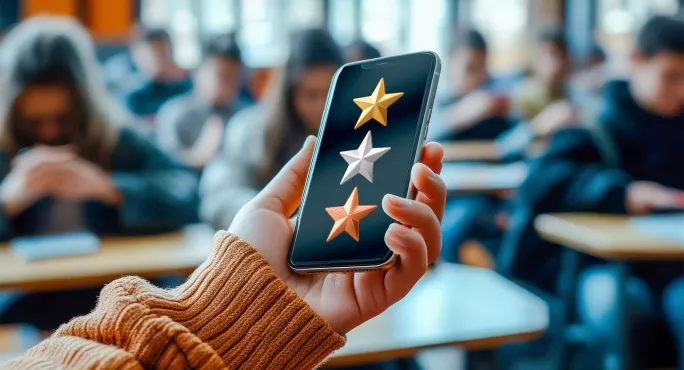
School phone bans: Why we’ve launched a rating system

The issue of mobile phone use in schools continues to dominate many debates, and many school leaders are using the summer term to review their policies and plan for a different approach in the next academic year.
There are numerous factors driving this, from government guidance last year encouraging a “ban” on smartphones to political and cultural debate, sparked by, among other things, reading The Anxious Generation and watching Adolescence.
However, it remains the case that in many schools, students, teachers and leaders spend too much time thinking about or dealing with the impact of these devices.
Phone bans in schools?
Schools are taking action, of course, with many implementing policies that involve locking away smartphones. In primary schools this is often achieved relatively easily, with the school office or class teacher collecting devices.
In secondary, though, where schools are larger and phone ownership is more prolific, significant investment in systems is required.
The effort is worth it, though, with schools that have introduced “lock away” systems reporting transformational change in the behaviour of students by giving them the opportunity to have a clear, six-hour break from their devices, improving social engagement and learning.
But there’s a problem. The negative impacts of smartphones on child development are hard to exaggerate, and they are almost all happening outside of school hours.
Access to unsupervised, immediate and unlimited social media, messaging, dark web content and pornography make smartphones wildly inappropriate to be part of children’s lives.
Smartphone use is linked to poor mental health, obesity, bad eyesight, poor bone development and slower learning. Yet young teens are spending, on average, 28 hours a week on their smartphones.
One in five has usage that can be classed as an addiction. These stark and concerning facts present the contextual backdrop for headteachers around the country grappling with their smartphone policy.
Benefits of a complete ban
A growing number of schools have opted for a complete ban, meaning that no smartphones are allowed on the site at all.
For example, in the London authorities of Barnet, Ealing and Brent, primary schools have agreed to prohibit smartphones on site from September 2025.
These policies shoot for a bigger goal of creating a new normal for young children - a childhood free from the dangers of smartphones.
Policies that lock away phones continue to normalise ownership, whereas the healthiest message, particularly at primary level, is simply that these devices aren’t safe.
What’s more, for the almost 150,000 parents who have signed Smartphone Free Childhood’s pledge to delay giving their child a phone until at least age 14, this ban supports them in making it normal for their child to enjoy school without the harms of smartphones.
The new rating system
Within this context, a group of us have come together with the goal of shining a light on this issue. By categorising school phone policies into three simple levels, we believe we can help to support schools, inform parents and, ultimately, help children to thrive.
As with any simplification, there will be nuance lost. But, on balance, we believe the ability for schools and parents to readily understand and engage with these levels will have real benefits.
The smartphone policy levels are defined as:
- Gold: No smartphones on site.
- Silver: Smartphones are locked away.
- Bronze: Smartphones are never used, but stay with the pupil.
We want to recognise the excellent work that schools are already doing to protect children from the harms of smartphones.
While so much better than a “do nothing” approach, policies that leave phones in children’s pockets will have less positive impact than those that lock them away and completely remove the distraction. And both of these policies lack the higher ambition of complete bans - to create a new normal where children do not have unsupervised access to smartphones and social media at school or at home until later adolescence.
For this reason, in consultation with a large number of headteachers, we have implemented this simple rating system to support schools and parents to engage with this topic and drive the conversation forward.
The ratings system also allows schools to capture aspects of their policies they are especially proud of, which could include their curriculum teaching about the risks of smartphone use in childhood, the robust nature of their policy implementation, their approach to adults modelling smartphone use or how they deal with the use of phones on trips.
By capturing these details, we hope schools will be able to share best practice with one another. The ratings system goes live today. Schools can share their approach by completing a short registration process at www.smartphonefreerating.org.
Max Haimendorf OBE is founding principal of Ark King Solomon Academy in London
You can now get the UK’s most-trusted source of education news in a mobile app. Get Tes magazine on iOS and on Android
Register with Tes and you can read five free articles every month, plus you'll have access to our range of award-winning newsletters.
Keep reading for just £4.90 per month
You've reached your limit of free articles this month. Subscribe for £4.90 per month for three months and get:
- Unlimited access to all Tes magazine content
- Exclusive subscriber-only stories
- Award-winning email newsletters
You've reached your limit of free articles this month. Subscribe for £4.90 per month for three months and get:
- Unlimited access to all Tes magazine content
- Exclusive subscriber-only stories
- Award-winning email newsletters
topics in this article



